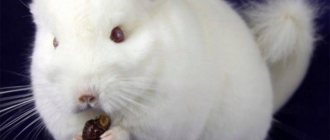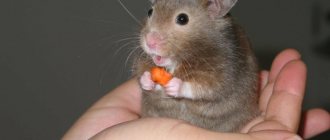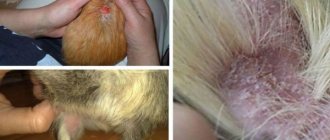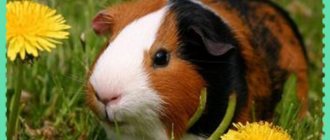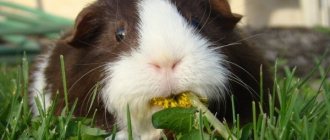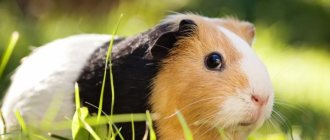The guinea pig is a species of semi-ungulate rodent. The second English name is “kewi”. The pet is affectionate, easy to care for and can become a good friend to a child. The animal teaches the baby care and responsibility. The pig is larger in size than mice, hamsters and rats. She has short legs with claws, a small neck, hard fur and practically no tail. A rodent's teeth are small and grow throughout its life.
There are breeds with long and short hair. Photos of guinea pigs are presented in nurseries and other sources. Small individuals have difficult to distinguish sexual characteristics.
Experts have learned to determine by the lower abdomen. Two males cannot live in one cage. It is better to choose either opposite-sex pairs or two females.
Breeds
Currently there are more than 80 varieties. Each breed of guinea pig has its own characteristics in appearance and habits.
The most popular ones can be identified:
American. Short fur of different colors, large eyes and a crooked nose. Affectionate and playful animal.
Peruvian. The most ancient breed. The wool can reach a length of up to 50 cm. The colors are different.
Skinny. The rodent has no fur at all. The animal is afraid of direct sunlight and cold. In appearance they resemble hippopotamuses.
Note!
- How to choose a mattress and not make a mistake? Review of the best models, size table
- Cotton blanket: advantages and disadvantages, rules of choice and care
- Review of ideas for exterior home decoration
Alpaca. They are distinguished by fluffy and curly hair. The eyes are shiny, usually matching the coat, and the ears are large and hanging. Smart pet.
Teddy. The breed appeared by chance in 1978, but has already gained popularity. This pet guinea pig looks like a teddy bear and children adore it. In small individuals, the fur is curly, but straightens with age.
Satin. The rodent's fur shines in the sun and feels like silk. The color is usually monochromatic. An unusually beautiful pig.
Kui. It can reach very large sizes and weight. The breed is equated to rabbits. The cage will be very cramped for your pet; it is better to keep it in a pen.
Himalayan. An animal with red eyes and white fur. There are spots on the nose and ears. Requires ambient temperature control and appropriate care.
Note!
- How to protect a gazebo from rain and wind in summer and snow in winter - a review of the best options
Chicken - description, types, classification, nutrition and maintenance of domestic chicken (115 photos and videos)
- Fretka - lifestyle, care and character traits. 115 photos and videos tips for keeping a pet ferret
Rosette. This breed got its name from the type of wool. The entire cover consists of small rosettes. The ears are large and do not stick out.
Rex. It is also called the royal pig. It has short fur of various colors. The breed is prone to obesity.
The fluffiest of fluffies
Rex
Rex is considered one of the newly developed breeds. They should not have rosettes; the hair on the head is usually coarser than on the back and sides. Due to the nature of the Rex guinea pig's coat, they sometimes need to be brushed with a special brush. Interestingly, this is one of the most intelligent breeds that can be trained. They need the company of their relatives more than others.
American Teddy
This breed is also one of the fluffiest and largest. They can be identified by their drooping ears and predominantly coarse coat.
The thickest wool is Alpaca
The Alpaca breed has a very thick, long, curly coat. They were bred back in the 19th century in South America. The main external differences are that there are several rosettes on the muzzle and the back of the body, and the growth of the cover on the legs from bottom to top. Alpacas are very friendly even towards strangers and have a calm character.
Left - Rex, middle - Teddy, right - Alpaca
Habits
In most cases, very calm and affectionate animals. Rodents show their character in an unusual way. If they are happy, they may jump around the cage and make squeaking noises.
Small individuals are afraid of people and constantly hide in a safe place. It is necessary to accustom the animal to hands carefully without stress.
Aggression manifests itself only after the birth of offspring. For a month, the female will not let anyone near the babies and will defend herself in all known ways.
If the pig is chewing on the cage, then it is bored or there is not enough space. You can expand the cage, play more often, or add another individual. It is dangerous to chew on a cage.
The norm for these animals is to eat their own droppings. Thus, the animal saturates its body with the remaining beneficial substances.
But it’s better to clean the cage in time and expand the diet with vitamins. Your pig may chatter his teeth, which is a sign of stress. It is necessary to temporarily remove irritants.
Lifespan
In the right and comfortable conditions for keeping guinea pigs, the animal can live up to 10 years. There are also individuals 15 years of age. It all depends on diseases, care, breed and other factors. In nature, rodents live much shorter lives. Heavy weight and natural selection have an effect.
Description and appearance
The appearance of long-haired guinea pigs differs from short-haired representatives of the breed in the length of their coat. In the former, the length of the curls reaches 20–50 cm and sometimes covers the entire muzzle. And in terms of body structure and size, they are no different from their short-haired relatives.
The weight of pigs is 1.5 - 2 kg, body length is about 30 cm. Life expectancy is about 10 years, puberty occurs by the 10th month from birth. Pigs come in different colors, the most common being red.
The character of long-haired rodents is calm. These are sociable animals that regularly require communication either with their owners or with relatives. They get along well with other pets.
Long-haired breeds include:
- Peruvian;
- Sheltie;
- alpaca;
- coronet;
- texel.
Cage requirements
Guinea pigs can be kept in terrariums and aquariums. But the most common home is a cage. The larger the size, the better for the rodent. The cage should be placed in a bright place, but not exposed to direct sunlight.
It is advisable to keep it quiet, but people should be in sight. There should be no tall structures in the cage itself. Any fall is dangerous to health and life.
The bottom must be covered with sawdust or pebbles. You can hang a hammock and a house for shelter.
Keeping at home
After acquiring an animal, its behavior can be quite sluggish and ambiguous, as the animal gradually gets used to the new living conditions. During this period, the guinea pig has a poor appetite, it is frightened by various movements and sounds, so it can sit motionless in one place for a long time. The adaptation process can and should be accelerated by creating a certain atmosphere in the home, characterized by calm and attention.
Cage, filling
In fact, guinea pigs are considered to be quite timid by nature, so they react negatively to changes in their living conditions. Animals can be kept either in a terrarium or in a cage with a tray, with the second option being more preferable. In the cage, it is necessary to provide something like a resting house (for sleeping), as well as place various game elements, a feeder and a drinking bowl. Naturally, the size of the house should take into account the size of the animal itself.
Care, hygiene
Guinea pigs do not tolerate both cold and excessive heat in the form of direct sunlight, so it is necessary to protect your pet from these negative factors. Water treatments are provided to the guinea pig as needed. Once a week you should brush your coat. Since the claws are unlikely to wear down naturally, they should be trimmed once a week.
If an animal participates in exhibition shows, then such a pet requires special attention. From an early age, they should be taught to sit still in one of the postures, and they should also be taught to patiently endure the daily processes of brushing. In this case, the animal must withstand the process of using the pills. Wire-haired and smooth-haired guinea pigs undergo periodic trimming.
What to feed
In the natural environment, guinea pigs eat components of plant origin, which include roots and seeds of plants, leaves, and fruits that have fallen from trees or shrubs. The basis of the diet of a domestic guinea pig is high-quality hay, which normalizes the functioning of the digestive system and also allows the rodent to grind its teeth. Due to the peculiarities of the digestive system, hay should be given to your pet quite often, but in small portions.
Good to know! Experts recommend feeding guinea pigs with ready-made food, at a rate of no more than one tablespoon per day.
Naturally, no one would recommend feeding a guinea pig exclusively with hay, so its diet should include succulent food in the form of berries, fruits and vegetables. As a treat, you can offer the animal sweet fruits, berries and the fruits of other cultivated plants. In order for the animal's teeth to constantly wear down, the animal must receive twigs of a cherry or apple tree, dandelion or celery root. The guinea pig's cage must contain fresh, clean water, and it must be changed every day.
Guinea pigs are exclusively herbivores, so any food items of animal origin should be excluded from the diet. In addition, it is not recommended to feed the pig milk, which can lead to upset of the animal’s digestive tract, since its body does not digest lactose well. The use of low-quality feed, as well as frequent and, especially, drastic changes in diet contribute to the development of various ailments, and often cause death.
Health, diseases and their prevention
The most common diseases that guinea pig owners may encounter are:
- Worms and external parasites.
- Alopecia or hair loss, which is the result of improper feeding of the animal, stress, lack of vitamins and minerals, as well as the appearance of parasites.
- Injuries and even fractures of limbs, which is associated with violation of maintenance rules.
- Rickets as a consequence of a lack of vitamin D.
- Colds (ARI), pneumonia, otitis media and cystitis, as a result of hypothermia or drafts.
- Anomalies of dental incisors.
- Disturbances in the digestive system. As a result, the animal develops diarrhea, constipation, flatulence or enteritis.
- Keratitis and conjunctivitis, as a result of exposure to infections, chemical and mechanical factors.
Improper nutrition (imbalance of nutritional components) leads to excess weight in your pet, which does not lead to anything good.
Reproduction and offspring
At the age of six months, you can already start mating guinea pigs. This process is possible within 2 weeks, while fertilization is possible within 8 hours. After pregnancy, the female carries her future offspring for about 2 months.
From 2 to 5 cubs are born, which are well developed and move independently. For a couple of months, the female feeds her cubs, but not longer.
Nutrition
It is important to know what guinea pigs eat so that there are no health problems for your pets. In nature, the rodent feeds on seeds, berries, leaves and roots.
At home, pigs need to eat hay and ready-made balanced feed. For dessert, you can give him nibble on fresh vegetables, salad and fruits.
To allow teeth to be ground down, cherry branches are placed in the cage. It is more convenient to pour water into the sippy cup every day, so it will not spill and will provide the pet with the necessary moisture.
Texels
Texel is one of the most beautiful breeds, known since the mid-80s of the last century. Texels are distinguished by long, thick fur that breaks up into clearly defined curls, a long train and fluffy sideburns. The length of the coat is 12-18 cm. The rounded muzzle is decorated with large expressive eyes. Texels are calm, friendly and sociable.
Looking at the photo of a Texel guinea pig, it seems that caring for such luxurious fur requires special effort. In reality, they do not require daily brushing, and it does not take much time to select hay and sawdust from their fur. Animals that do not take part in exhibitions usually have their fur shortened.
Merino
The curly coat grows in the same way as the Texel, only there is a rosette on the head.
Agouti
Agoutis are the ancestors of all modern breeds. Each animal's hair has different shades at the base and at the end.
Roans
The head, paws, ears are painted in the main color without any admixture of another shade, only on the body there is a so-called salt and pepper mixture, when hairs of one color are mixed with hairs of another color.
Teddy
Teddies are similar to Rex cats, but their fur is slightly shorter and softer. Thick, dense and elastic, straight (or slightly wavy), the hair stands on end all over the pig's body, and feels like plush. Pictured is a Gold and White American Teddy
Rex
The main difference between Rex guinea pigs is their hard, dense, slightly curly fur, about 1.7 cm long. The hairs stand on end, which creates a plush effect. Color options can be any.
Ridgeback
It is a smooth-haired pig, but there is a difference - there is a rosette on the rump, and on the back the hair is collected into a kind of comb of standing vertical hair.
Cresteds
Smooth-haired pigs with a rosette on the crown. There are English and American Cresteds. In American cats, the color of the rosette should contrast with the color of the main color; in English cats, it should be identical to it.
Satin guinea pigs
A distinctive feature of the satin pig group is its surprisingly soft, silky coat with a glossy effect. The wool shines and shimmers due to the special hollow structure of the hairs. The Satin coat type is found in all short-haired and long-haired breeds. The rarest animals are golden, lilac and buffalo in color.
Himalayans
The main color of the entire body is pure white, only the ears, nose and paws are black or brown.
Kui
Giant guinea pigs are native to South America. At birth they weigh 100–150 g, and adults can reach a weight of 3–4 kg. Kui owners note that their pets are not as trusting of humans as ordinary pigs, they are more cowardly, and the females treat each other quite aggressively.
Galloway
Newly registered pig breed. A characteristic feature is plain wool with a white belt on the back.
Other care
- Your guinea pig's nails need to be trimmed as they grow.
- It is often not worth bathing an animal. Pigs are clean.
- Long hair is brushed once a week.
- Clean the cage every 4 days and whenever it gets dirty.
- The body must be examined for injuries, cuts and parasites.
Selfies
Selfies are one of the ancient representatives of the pig family. They were developed in Great Britain in the 19th century. A distinctive feature of Selfies is their uniform (solid) coat color (white, black, brown, beige, lilac, etc.). The eyes are often dark, but can also be red. The photo shows a guinea pig of the English Self breed.
One interesting feature of this breed has been noticed: females living together in the same cage or enclosure take care of the offspring through joint efforts; we can say that these are the only family rodents of their kind.
Diseases
The animal does not get sick often, but when the first signs are detected, it is necessary to begin treatment. It is better to trust a professional doctor who will select the optimal treatment.
The most common diseases are: worms and parasites, gastrointestinal disorders, colds, dental anomalies and eye infections.
Reproduction
Animals can start mating at 10 months. After mating, it is recommended to remove the pig before the birth of offspring. Pregnancy lasts on average two months (the exact period depends on the number of babies). During this period, the female should be left alone.
Labor usually occurs naturally within an hour. If the pig cannot give birth, then you need to call a veterinarian. If the birth is successful, the pet will gnaw the umbilical cord itself. If this does not happen, then it can be cut with sterile instruments.
Owner reviews
Breeders of pigs with chic hairstyles say that these animals require careful care. Their character is also called difficult. They are picky eaters and have a hard time with hygiene procedures.
Rodents are quite voracious. If there is no garden, feeding a pet will cost about 4,000 rubles. Additionally, you need to visit a veterinarian.
Breeders warn that long-haired pets shed all year round. This means that hair from the animal will need to be removed regularly, or it will be everywhere.
Training
The guinea pig is trainable. Different individuals may need additional time to learn.
Most popular tricks:
- respond to a name and come to a call;
- stand on hind legs when required;
- run in a circle for a treat;
- roll the ball and climb over the hoops;
- go to the toilet in the tray.
